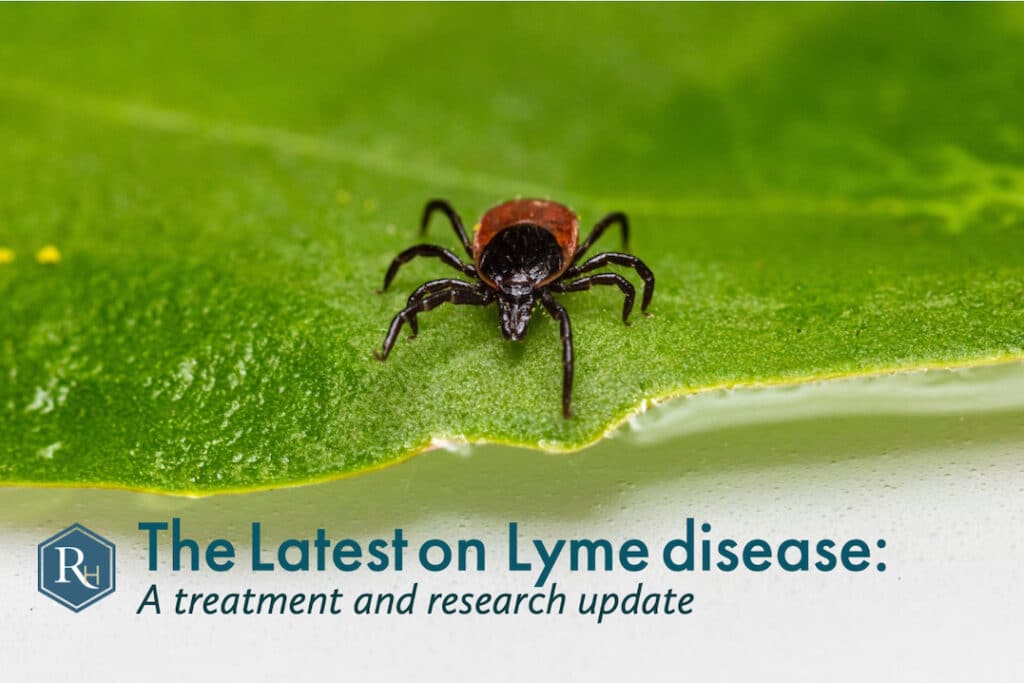The Latest on Lyme Disease: A Research and Treatment Update

The middle of winter may seem like an odd time to write about tick-borne Lyme disease, but here in Southern California, tick season is year-round. In fact, for those already infected with the bacteria that causes Lyme disease, there is no off-season. Likewise, Lyme research continues unabated throughout the year, increasing our knowledge and insight into this elusive, tenacious, and often devastating disease.
In this post, we review the latest Lyme disease research, including key factors that determine treatment effectiveness, as well as genetic variations that make Lyme harder to treat. We’ll also bring you up to date on the identification of a protein that may protect against Lyme.

(Image by Erik Karits, used with permission via Unsplash)
Does a Certain Protein Protect Against Lyme Disease?
Why Lyme symptoms and symptom severity differ among patients remains a mystery, but one explanation could be variations in the amount of a certain protein the body produces. In a recent article published in PLOS Pathogens, Yale University researchers report the discovery of a protein that helps protect hosts from the bacterium that causes Lyme disease.
When exposed to the bacterium, the protein, Peptidoglycan Recognition Protein 1 (PGLYRP1), triggers an immune system response against the bacterium. The researchers exposed mice with and without PGLYRP1 to the Borrelia burgdorferi bacterium. Mice without the protein showed signs of immune system dysfunction and had much higher levels of the Borrelia burgdorferi bacterium.
“Stimulating the ability of people to make more of this protein could help fight infection,” wrote Yale’s Erol Fikrig, the Waldemar Von Zedtwitz Professor of Medicine (Infectious Diseases) and professor of epidemiology (microbial diseases) and of microbial pathogenesis and co-corresponding author of the study.
Fikrig and his colleagues are also investigating whether people with higher levels of PGLYRP1 may be less susceptible to infection by B. burgdorferi, which would help explain why some infected individuals have better outcomes.
For additional details, you can access the entire journal article: A human secretome library screen reveals a role for Peptidoglycan Recognition Protein 1 in Lyme borreliosis.
Accounting for Genetic Variations of Borrelia Species and Strains
One of the challenges with Lyme disease is that people often assume that the bacterium responsible for the disease is the same in every patient, regardless of their symptoms, the severity of their symptoms, and their response to treatment. This false assumption can cause several problems, including the following:
- Patients and doctors may become dismissive of the potential seriousness of Lyme disease because some strains cause only mild symptoms.
- Doctors may fail to account for the fact that certain strains of the bacteria are more resistant to antibiotics or that treatment duration may need to be longer in some cases.
- Information about the illness may be misleading. For example, according to the CDC, the erythema migrans (EM) rash that is characteristic of Lyme occurs in approximately 70 to 80 percent of all cases. However, Sunny Raleigh, DO, our Co-founder and Medical Director hails from Maine, where the rash appears in only about 40 to 50 percent of cases. As a result, many doctors and patients are more likely to rule out Lyme disease, simply due to the absence of an EM rash.
The fact is, there are multiple strains of Borrelia burgdorferi (the bacterium that causes most cases of Lyme disease), each differing genetically from one another. Each strain has the potential to cause different symptoms and variations in the severity of symptoms.
During a meeting of the U.S. Dept. of Health & Human Services’ Tick-Borne Disease Working Group (TBDWG) late last year, Yan Zelener, Director of Science for LymeTV, highlighted the importance of recognizing the challenges that difference strains of the bacterium pose:
In the absence of tests that can differentiate between a mild and a dangerous strain of Borrelia, it seems prudent to explicitly inform doctors and patients about the variability in risk from Lyme disease.
We encourage the TBDWG to re-frame the presentation of risks from a Borrelia infection on the basis of genetics. This will make patients and clinicians be less dismissive of Lyme disease and allow them to understand its potential to be a very serious illness in a subset of cases.
Different strains of a pathogen are not unique to Borrelia burgdorferi. We are currently seeing multiple variants of the coronavirus, and different strains of the pathogens that cause HIV, malaria, and tuberculosis give rise to clinical variations in these diseases — differences in symptoms, severity of symptoms, and responses to treatments.
For more about the Tick-Borne Disease Working Group and to access its notices and updates, visit its website.
Recognizing Three Key Factors for Effective Treatment
Antibiotics have long been recognized as the first-line treatment in the battle against Lyme disease. That certainly makes sense, because Lyme disease is caused by the bacterium Borrelia burgdorferi (and rarely Borrelia mayonii), transmitted to humans through the bite of infected ticks. According to the Centers for Disease Control and Prevention (CDC), “Most cases of Lyme disease can be treated successfully with a few weeks of antibiotics.”
However, many Chronic Lyme Disease (CLD) patients do not respond well to short-term antibiotic treatment, leaving researchers to wonder what other factors play a role in improving patient outcomes. In a recent article titled Are Antibiotics Useful for Treating Chronic Lyme Disease Patients? Lorraine Johnson, JD, MBA, and Chief Executive Officer of LymeDisease.org, identifies three key factors for effective treatment of the disease. In this study, high treatment response is most closely associated with the following three factors:
- The use of antibiotics or a combination of antibiotics and alternative treatments
- Longer duration of treatment, and
- Oversight by a clinician whose practice focuses on the treatment of tick-borne diseases.
A previous study examined treatment response variation in a sample of more than 3,500 patients enrolled in the MyLymeData patient registry developed by LymeDisease.org. That study identified three treatment response subgroups among Lyme disease patients who remained ill:
- Non-responders
- Low responders
- High responders
The new study added a fourth subgroup — patients considered to be well. High responders and well patients reported substantially higher quality of life, a greater percentage of improvement, and reduction in symptom severity.
The study’s results support what many of us in the world of Lyme disease treatment have experienced: “Given antibiotic treatment for a sufficient period of time, patients with CLD can improve, and some will improve enough to identify themselves as being well.”
However, because patients with CLD form a heterogenous group of people who respond differently to antibiotic treatment, doctors like those here at Restoration Healthcare play a key role in personalizing treatment. Until biomarkers are identified to help us predict each patient’s response to treatment, we rely on our own clinical judgment to determine the best treatment approach, assess each individual’s response to treatment, and decide how long to continue treatment.
What’s clear from these three studies is the importance of taking a personalized approach to treating Lyme disease and having an expert supervise treatment. Although many people living with Lyme disease respond well to a few weeks on antibiotics, that one-size-fits-all approach isn’t effective for every patient. And without effective treatment, what starts with only mild flu-like symptoms can develop into severe health conditions impacting the heart, nervous system, and immune system.
Here at Restoration Healthcare, we are fortunate to have one of the leading Lyme specialists serving as our medical director. Dr. Raleigh is widely recognized by patients and referring physicians from across the country as one of the top Lyme doctors around. And in Southern California, no medical team may be better prepared to help patients with Lyme disease than the one Dr. Raleigh leads here at our functional medicine practice in Irvine.
If you have been bitten by a tick or are experiencing any symptoms that make you suspect that you may have Lyme disease, we strongly encourage you to make an appointment as soon as possible for an evaluation. We can confirm or rule out Lyme disease and, if necessary, develop a personalized plan of care that’s best for you. Whether you have Lyme disease or something else that’s making you feel less than 100 percent, we will look beyond the symptoms to identify and treat the root cause(s) of whatever is ailing you.
– – – – – – – – – –
Disclaimer: The information in this blog post about Lyme disease, is provided for general informational purposes only and may not reflect current medical thinking or practices. No information contained in this post should be construed as medical advice from the medical staff at Restoration Healthcare, Inc., nor is this post intended to be a substitute for medical counsel on any subject matter. No reader of this post should act or refrain from acting on the basis of any information included in, or accessible through, this post without seeking the appropriate medical advice on the particular facts and circumstances at issue from a licensed medical professional in the recipient’s state, country or other appropriate licensing jurisdiction.

